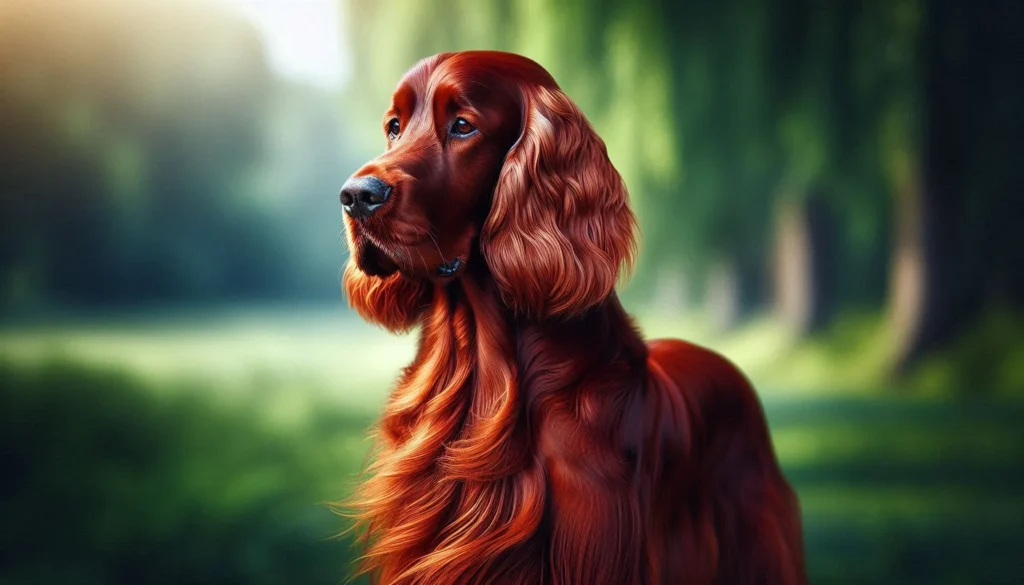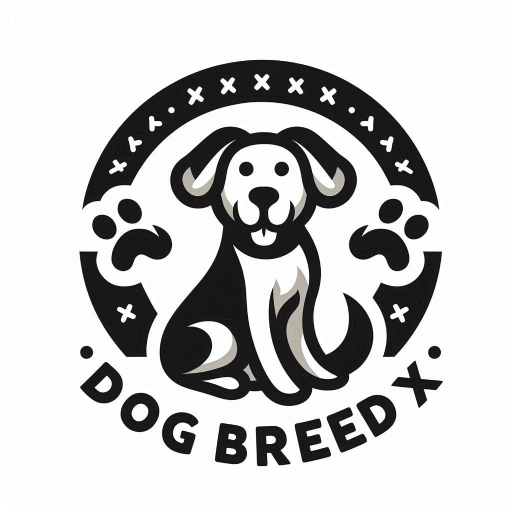Table of Contents
Irish Setter Dog Breed
The Irish Setter, known for its stunning red coat and lively personality, is one of the most beloved dog breeds among enthusiasts and families alike. With its graceful appearance, boundless energy, and affectionate nature, the Irish Setter stands out as a versatile companion. Whether you’re looking for a family pet, a hunting partner, or a loyal friend, the Irish Setter is a breed that can fulfill multiple roles. This article delves into the fascinating world of the Irish Setter, exploring its history, physical characteristics, temperament, and more to help you understand what makes this breed so special.
Irish Setter Dog History and Origin

The Irish Setter’s origins can be traced back to the 18th century in Ireland, where it was bred as a hunting dog. Initially, Irish Setters were not exclusively red; they came in a mix of red and white. These dogs were developed by crossing several breeds, including the English Setter, Spaniel, Pointer, and the Irish Terrier. The aim was to create a breed with an excellent sense of smell, speed, and stamina for hunting birds, particularly game fowl.
Over time, breeders began to favor the solid red coat, leading to the distinctively red Irish Setter we know today. The breed gained popularity outside of Ireland during the 19th century, particularly in the United States, where it became a favorite among hunters and dog show enthusiasts. The Irish Setter was recognized by the American Kennel Club (AKC) in 1878, solidifying its status as a distinguished breed.
Irish Setter Dog Physical Characteristics

The Irish Setter is a medium to large sized dog, known for its elegant and athletic build. Here are some of the key physical characteristics:
- Size: Males typically stand between 27 to 30 inches tall at the shoulder, while females are slightly smaller, measuring 25 to 28 inches. They usually weigh between 60 to 70 pounds.
- Coat: The breed’s most striking feature is its long, silky, and feathered coat. The coat is straight and can be slightly wavy, providing the dog with a luxurious appearance.
- Color: The classic color of the Irish Setter is a rich chestnut or mahogany red. The coat may have a few white markings on the chest, throat, or toes, but a solid red coat is most desired.
- Distinctive Features: The Irish Setter has a long, chiseled head with almond-shaped, dark brown eyes that give it an expressive and intelligent look. The ears are long and set low, hanging close to the head, and the tail is moderately long with a feathered appearance, carried in a lively manner.
Temperament and Personality
The Irish Setter is celebrated for its exuberant and friendly temperament. Known for their playful and outgoing nature, these dogs thrive on human interaction and are particularly fond of children. Here are some of the key traits:
- Affectionate: Irish Setters are known for their loving and gentle nature. They form strong bonds with their families and are often described as velcro dogs because they love to stay close to their owners.
- Energetic: This breed is highly energetic and requires plenty of physical activity. Irish Setters are natural athletes, excelling in activities like running, fetching, and agility training.
- Intelligent: Irish Setters are smart and quick learners, but their independent streak can sometimes make them a bit stubborn. Positive reinforcement and consistent training are key to managing their intelligence.
- Sociable: Irish Setters get along well with other dogs and pets. Their friendly disposition makes them poor guard dogs, as they are more likely to greet a stranger with a wagging tail than with suspicion.
- Playful: Their playful and sometimes goofy nature makes them a joy to have around, especially in a family setting where there are children to match their energy levels.
Health and Lifespan

Like all breeds, the Irish Setter is prone to certain health issues. However, with proper care, these dogs can lead long and healthy lives. The average lifespan of an Irish Setter is between 12 to 15 years. Common health concerns include:
- Hip Dysplasia: This is a genetic condition where the hip joint doesn’t fit properly into the hip socket, leading to arthritis and pain. Regular exercise and maintaining a healthy weight can help manage this condition.
- Bloat: Also known as gastric torsion, bloat is a life-threatening condition where the stomach twists, trapping gas inside. It’s important to feed Irish Setters smaller, more frequent meals and avoid vigorous exercise immediately after eating.
- Progressive Retinal Atrophy (PRA): This is a group of degenerative eye disorders that can lead to blindness. Regular veterinary check ups and genetic testing can help identify this condition early.
- Ear Infections: Due to their long, floppy ears, Irish Setters are prone to ear infections. Regular ear cleaning and monitoring for signs of infection are essential to keep their ears healthy.
Tips for Keeping an Irish Setter Healthy
- Regular Exercise: Ensure your Irish Setter gets plenty of physical activity every day. A couple of long walks, combined with playtime, is ideal.
- Balanced Diet: Feed your Irish Setter high-quality dog food appropriate for their age, size, and activity level. Avoid overfeeding to prevent obesity.
- Veterinary Care: Regular check ups with the vet are essential to monitor your dog’s health and catch any potential issues early.
Irish Setter Dog Care and Grooming

Caring for an Irish Setter requires attention to their grooming and exercise needs. Here’s what you need to know:
- Grooming: The Irish Setter’s long silky coat requires regular grooming to prevent tangles and mats. Brush your dog at least three to four times a week. During shedding season, daily brushing may be necessary. Regular baths are also important to keep their coat looking its best.
- Exercise: Irish Setters are high energy dogs that need plenty of exercise to stay happy and healthy. Aim for at least 60 to 90 minutes of physical activity each day. This can include walks, runs, or playtime in a secure, fenced yard.
- Diet: Feed your Irish Setter a balanced diet rich in protein to support their active lifestyle. Consult your vet for specific dietary recommendations, and be mindful of portion sizes to prevent weight gain.
- Dental Care: Regular brushing of your dog’s teeth is important to prevent dental diseases. Dental chews and toys can also help maintain oral hygiene.
- Nail Trimming: Regular nail trimming is essential to prevent overgrowth, which can cause discomfort or injury.
Training and Socialization
Training an Irish Setter can be both rewarding and challenging. Their intelligence and energy make them eager learners, but their independent nature requires patience and consistency. Here’s how to approach training and socialization:
- Positive Reinforcement: Use positive reinforcement techniques like treats, praise, and play to encourage good behavior. Avoid harsh training methods, as these can damage the trust between you and your dog.
- Early Socialization: Introduce your Irish Setter to various people, animals, and environments from a young age. This helps them grow into well adjusted and confident adults.
- Obedience Training: Start with basic commands like sit, stay, come, and heel. Irish Setters can be stubborn, so short, consistent training sessions are more effective than long, repetitive ones.
- Crate Training: Crate training can be beneficial, especially for housebreaking and providing a safe space for your dog. Ensure the crate is comfortable and never use it as a form of punishment.
Suitability as a Family Pet

The Irish Setter is an excellent choice for active families who can meet the breed’s exercise and social needs. They thrive in homes where they have plenty of space to run and play. Here are some factors to consider:
- Living Environment: Irish Setters do best in homes with large, fenced yards where they can burn off energy. While they can adapt to apartment living, it requires a significant commitment to daily exercise.
- Children: Irish Setters are great with children. Their playful and gentle nature makes them ideal playmates, though their exuberance might be too much for very young children.
- Other Pets: They generally get along well with other dogs and can coexist peacefully with cats, especially if raised together.
Fun Facts and Trivia
- Movie Star: The Irish Setter gained fame as a movie star in the 1943 film “Big Red,” which was based on a novel about an Irish Setter.
- Presidential Pet: An Irish Setter named “King Timahoe” was owned by U.S. President Richard Nixon.
- Bird Dogs: Irish Setters are still used as hunting dogs today, especially for hunting upland game birds.
Similar Dog Breeds



If you’re interested in the Irish Setter, you might also consider these similar breeds:
- English Setter: Known for their distinctive speckled coat, English Setters are also excellent hunting dogs with a friendly and gentle demeanor. They are slightly larger than Irish Setters and have a more laid back temperament.
- Gordon Setter: The Gordon Setter is a Scottish breed, larger and sturdier than the Irish Setter. They have a black and tan coat and are known for their loyalty and protective nature, making them excellent family pets and hunting companions.
- Golden Retriever: While not a setter, the Golden Retriever shares many similarities with the Irish Setter, including a friendly disposition, intelligence, and a love for activity. They are slightly easier to train and make excellent family pets.
Conclusion
The Irish Setter is a vibrant, affectionate, and loyal breed that brings joy and energy into any home. With their stunning appearance and playful nature, they make excellent companions for active families and individuals. However, they require significant exercise, grooming, and attention to thrive. If you’re ready to invest the time and care needed, the Irish Setter can be a deeply rewarding addition to your family.
FAQs
Is the Irish Setter a dangerous dog?
No, the Irish Setter is not a dangerous dog. They are known for their friendly and gentle nature. While they may be excitable and energetic, they are generally not aggressive and get along well with people and other animals.
Is the Irish Setter the best guard dog to protect you or your family?
The Irish Setter is not typically considered a good guard dog. While they are alert and may bark at strangers, their friendly and sociable nature means they are more likely to greet a newcomer with enthusiasm rather than suspicion. If you need a guard dog, other breeds like the German Shepherd or Rottweiler might be more suitable.




